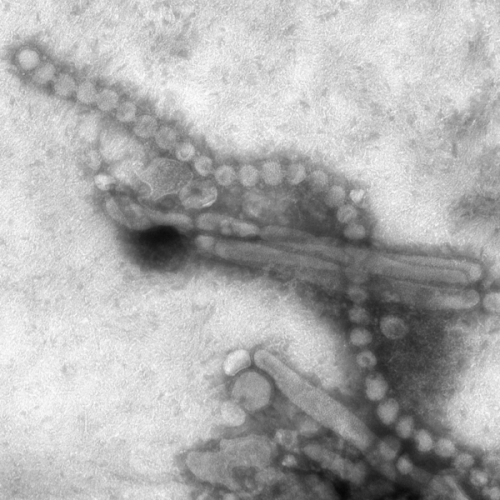March 23, 2017 report
Single nucleotide change responsible for allowing H7N9 flu to jump from birds to humans found

(Phys.org)—A team of researchers affiliated with several institutions in Hong Kong and mainland China has isolated a change in a single nucleotide that is responsible for allowing the H7N9 flu virus to replicate in both birds and humans. In their paper published in the journal Nature Communications, the team describes their efforts in searching for the factors involved when avian flu jumps to humans and what their findings could mean for reducing the spread of future flu epidemics.
Scientists around the world are very concerned about how viruses spread from animals to humans—the fear is that one day, a super-virus may emerge, one that is both easily transmissible and deadly, potentially killing millions of people around the globe. In this new effort, the researchers focused on H7N9, a flu virus that was first found to jump from birds (mainly chickens) to humans as recently as 2000. It has infected people mostly in China, but its recent history offered an opportunity to learn more about how a virus jumps to humans.
To learn more about the virus, the researchers obtained samples and subjected them to genetic analysis looking for any differences between them and other avian flu viruses that do not spread to humans. They found a unique nucleotide (an RNA building block) substitution called NS-G540A in the NS segment—a mutation that allowed the virus to replicate in both avian and human (and other mammalian) hosts. They report that they found the mutation on some other flu variants as well, such as H9N2.
The researchers note that in addition to learning more about how a virus can make the leap between species, the identification of the nucleotide also offers the medical community a biomarker—testing chickens and other fowl infected with a flu variant for the marker would allow for identifying birds carrying a flu variant that can cause infections in the people that handle them. They note also that they found no evidence that the mutation played a role in allowing the virus to spread between humans once it made the leap from an avian source.
More information: Xiaofeng Huang et al. An NS-segment exonic splicing enhancer regulates influenza A virus replication in mammalian cells, Nature Communications (2017). DOI: 10.1038/ncomms14751
Abstract
Influenza virus utilizes host splicing machinery to process viral mRNAs expressed from both M and NS segments. Through genetic analysis and functional characterization, we here show that the NS segment of H7N9 virus contains a unique G540A substitution, located within a previously undefined exonic splicing enhancer (ESE) motif present in the NEP mRNA of influenza A viruses. G540A supports virus replication in mammalian cells while retaining replication ability in avian cells. Host splicing regulator, SF2, interacts with this ESE to regulate splicing of NEP/NS1 mRNA and G540A substitution affects SF2–ESE interaction. The NS1 protein directly interacts with SF2 in the nucleus and modulates splicing of NS mRNAs during virus replication. We demonstrate that splicing of NEP/NS1 mRNA is regulated through a cis NEP-ESE motif and suggest a unique NEP-ESE may contribute to provide H7N9 virus with the ability to both circulate efficiently in avian hosts and replicate in mammalian cells.
Journal information: Nature Communications
© 2017 Phys.org


















